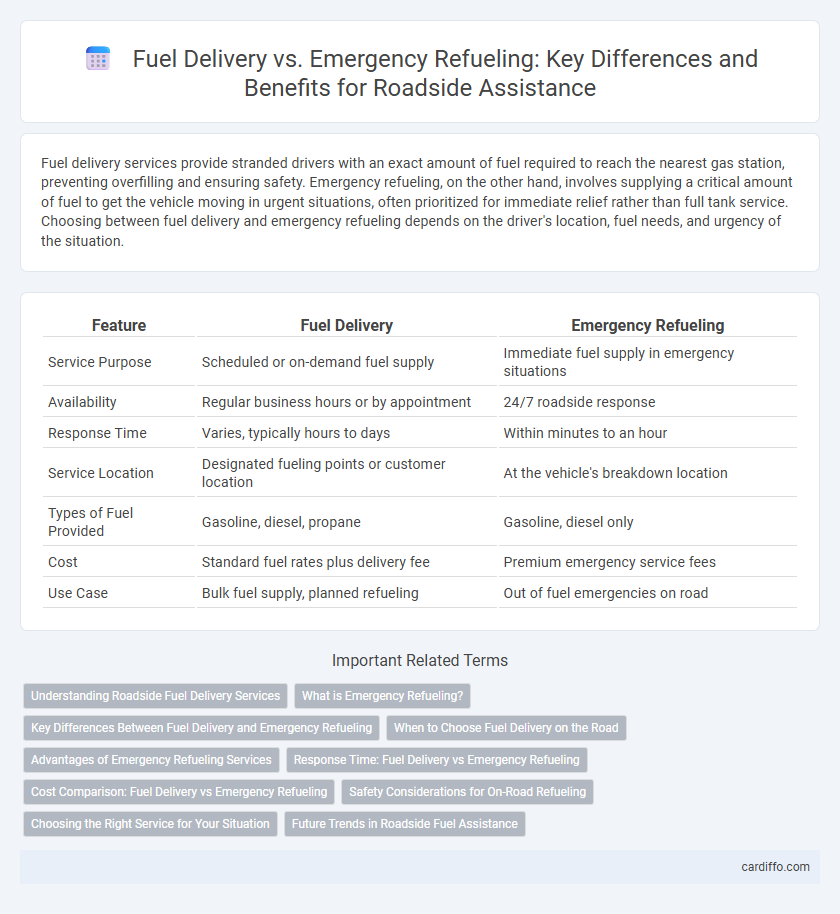Fuel delivery services provide stranded drivers with an exact amount of fuel required to reach the nearest gas station, preventing overfilling and ensuring safety. Emergency refueling, on the other hand, involves supplying a critical amount of fuel to get the vehicle moving in urgent situations, often prioritized for immediate relief rather than full tank service. Choosing between fuel delivery and emergency refueling depends on the driver's location, fuel needs, and urgency of the situation.
Table of Comparison
| Feature | Fuel Delivery | Emergency Refueling |
|---|---|---|
| Service Purpose | Scheduled or on-demand fuel supply | Immediate fuel supply in emergency situations |
| Availability | Regular business hours or by appointment | 24/7 roadside response |
| Response Time | Varies, typically hours to days | Within minutes to an hour |
| Service Location | Designated fueling points or customer location | At the vehicle's breakdown location |
| Types of Fuel Provided | Gasoline, diesel, propane | Gasoline, diesel only |
| Cost | Standard fuel rates plus delivery fee | Premium emergency service fees |
| Use Case | Bulk fuel supply, planned refueling | Out of fuel emergencies on road |
Understanding Roadside Fuel Delivery Services
Roadside fuel delivery services provide quick and convenient assistance by delivering fuel directly to stranded vehicles, helping drivers avoid the hassle of finding a gas station in emergencies. Unlike emergency refueling, these services are specifically designed for situations where running out of gas disrupts travel plans, ensuring minimal downtime on the road. Efficient fuel delivery companies use GPS tracking and real-time communication to optimize response times and reach customers promptly.
What is Emergency Refueling?
Emergency refueling is a roadside service that provides immediate fuel supply to vehicles that have run out of gas unexpectedly, preventing drivers from being stranded. This service delivers the exact fuel type needed directly to the vehicle's location, allowing for quick resumption of the journey without needing to tow the car to a gas station. Unlike regular fuel delivery, emergency refueling is designed for urgent, on-the-spot refills in critical situations.
Key Differences Between Fuel Delivery and Emergency Refueling
Fuel delivery services provide scheduled or on-demand gasoline or diesel refills to vehicles, often covering longer distances or non-urgent needs, while emergency refueling addresses immediate fuel shortages to avoid vehicle immobilization. Emergency refueling typically involves rapid response times and smaller fuel quantities to get a stranded vehicle operational, contrasting with the broader scope and quantities supplied by regular fuel delivery. The key difference lies in intent and urgency: fuel delivery focuses on convenience and proactive service, whereas emergency refueling prioritizes quick resolution of unexpected fuel deprivation.
When to Choose Fuel Delivery on the Road
Fuel delivery is the preferred choice when you run out of fuel unexpectedly and need quick, on-the-spot refueling without towing your vehicle. Emergency refueling services are ideal for drivers stranded on highways or in remote locations where gas stations are inaccessible. Opt for fuel delivery to minimize downtime during long trips and avoid the higher costs associated with emergency roadside assistance.
Advantages of Emergency Refueling Services
Emergency refueling services provide immediate fuel supply at the vehicle's location, eliminating the need to drive to a gas station and preventing prolonged delays. These services enhance safety by reducing hazards associated with stranded vehicles on busy roads or highways. Rapid response times and on-the-spot assistance ensure minimal disruption to travel plans, especially in remote or high-traffic areas.
Response Time: Fuel Delivery vs Emergency Refueling
Fuel delivery typically requires a longer response time, often ranging from 30 minutes to over an hour depending on location and availability. Emergency refueling services prioritize rapid response, aiming to reach stranded vehicles within 15 to 30 minutes to minimize delays. Faster response times in emergency refueling enhance roadside assistance efficiency and reduce driver inconvenience significantly.
Cost Comparison: Fuel Delivery vs Emergency Refueling
Fuel delivery services typically offer more affordable rates due to planned assistance and bulk fuel sourcing, whereas emergency refueling incurs higher costs related to urgency and specialized dispatch. Emergency refueling often includes premium fees for immediate response, resulting in a significantly higher price per gallon compared to scheduled fuel delivery. Cost efficiency favors fuel delivery when roadside assistance is non-critical, while emergency refueling is best suited for urgent, unexpected fuel shortages.
Safety Considerations for On-Road Refueling
Fuel delivery services ensure safe and certified fuel transfer by using specialized equipment and trained professionals, minimizing risks such as spills or fire hazards during roadside refueling. Emergency refueling, while faster for immediate vehicle immobilization, often lacks standardized protocols, increasing the potential for accidents or fuel contamination. Prioritizing certified fuel delivery providers significantly enhances on-road safety by adhering to strict safety regulations and using proper containment systems.
Choosing the Right Service for Your Situation
Fuel delivery service provides scheduled or on-demand fuel supply directly to your vehicle, ideal for planned needs or running low on fuel without an immediate crisis. Emergency refueling focuses on urgent assistance when stranded due to an empty tank, emphasizing rapid response to get you back on the road quickly. Selecting the right service depends on your situation's urgency, with emergency refueling prioritized for unexpected stops and fuel delivery suited for convenience and prevention.
Future Trends in Roadside Fuel Assistance
Future trends in roadside fuel assistance emphasize the integration of electric vehicle (EV) charging services alongside traditional fuel delivery, reflecting the growing adoption of EVs. Advanced telematics and AI-driven dispatch systems are optimizing fuel delivery routes and response times, enhancing efficiency and customer satisfaction. Autonomous fueling drones and robotic refueling units are emerging innovations poised to revolutionize emergency refueling by enabling rapid, contactless service in remote or hazardous locations.
Fuel Delivery vs Emergency Refueling Infographic

 cardiffo.com
cardiffo.com